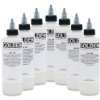How can I dye a cotton shirt so the pattern looks like spatters of blood?
—ADVERTISEMENTS—
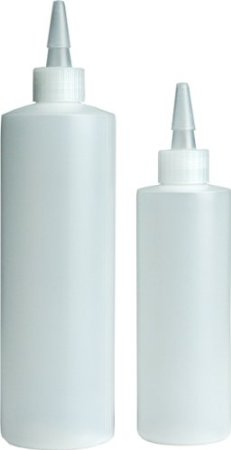
Jacquard 8oz Plastic Application Bottle
ideal for applying dye
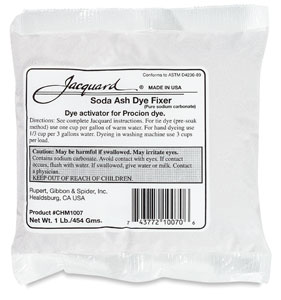
Jacquard Soda Ash
Dye Fixer
Soda ash fixes fiber reactive dye permanently in cotton. Does not work for all-purpose dyes such as Rit.
Country or region: USA
Message: Hey, I was wondering how to dye spots onto a cotton shirt. I want to achieve a look of blood spatters, but for it to be permanent. I know for RIT dye and other types you have to soak your cloth, but that wouldn't give me the blood spatters I'd like. So how, if it's possible, could I dye a cotton shirt so the pattern looks like blood spatter?
(Please help support this web site. Thank you.)
Tuesday, July 16, 2013
What wool dyes can I use to make wool fabric iridescent?
Country or region: Montana, USA
Message: I want to know which wash fast dyes or kiton dyes to use to dye iridescent wool fabric. I saw a recipe once and cannot find it now even with an interenet search. I would like to get the color purple on black as on a raven's wings, or the iridized green of a peacock or iridized blue also on a peacock. Can you help?
 Before applying either Pearl Ex or foils to your wool, you will want to dye it in your choice of background colors. If you examine a peacock's feather, you will see that the underlying color of the iridescent blue is actually black. Personally, my favorite black wool dye is the Lanaset Jet Black, a mixture of two black dyes which are extraordinarily permanent, compared to other wool dyes. They are so washfast that they can actually be washed in hot water, which will remove most other wool dyes. ProChem's Washfast Jet Black is my second favorite, also very washfast, and much less expensive to use. Other intense colors such as a deep turquoise blue would also make a good background.
Before applying either Pearl Ex or foils to your wool, you will want to dye it in your choice of background colors. If you examine a peacock's feather, you will see that the underlying color of the iridescent blue is actually black. Personally, my favorite black wool dye is the Lanaset Jet Black, a mixture of two black dyes which are extraordinarily permanent, compared to other wool dyes. They are so washfast that they can actually be washed in hot water, which will remove most other wool dyes. ProChem's Washfast Jet Black is my second favorite, also very washfast, and much less expensive to use. Other intense colors such as a deep turquoise blue would also make a good background.(Please help support this web site. Thank you.)
Wednesday, July 10, 2013
Color mixing....How can I mix Cushing dyes to make a Christmas Red?
—ADVERTISEMENTS—

Linda Knutson's book
Synthetic Dyes
for Natural Fibers
This essential book provides a thorough introduction to hand-dyeing.
Maryanne Lincoln's
book

Recipes from the Dye Kitchen
"Time-tested methods of dyeing gorgeous colors along with more than 30 color photos of rugs and wool swatches are included in this easy-to-use book. The swatches show the outcome of the more than 30 dye formulas provided and the formulas use both Cushing and PRO Chem acid dyes. Also included is a glossary of dyeing terms, step-by-step instructions for various dyeing methods, illustrations of dyeing equipment, lessons on color theory and planning, and tips for both novice and experienced dyers."
Message: I am trying to dye some wool a Christmas Red, do you have any suggestions as to what color combo to come up with this color over cream wool? I use Cushings dyes. Thank you.
If your red dye is producing a color that seems too pink to you for using as a Christmas red, you may need to use more dye, because using too little red makes pink. (Beware, though: using too much red acid dye will result in wool that keeps bleeding dye even after you have rinsed it for a long time.) If your red is more of a bright pure magenta, so that it is too blue in hue to use as a Christmas red, then you can mix a little bright orange dye with it, or yellow dye. Do not start with a red that is too dull in color, because you can't mix anything with a primary color to make it brighter. Be sure to do your color testing on the same wool that you will be working with in your project: using cream-colored wool instead of pure white will make your red a little duller, and will turn it a little more to the yellow side and less to the blue, so tests done on pure white wool will not be completely useful to you.
(Please help support this web site. Thank you.)
Tuesday, July 09, 2013
Do I need to remove brown prior to dyeing or can I dye right over the brown & achieve an eggplant type purple?
—ADVERTISEMENTS—
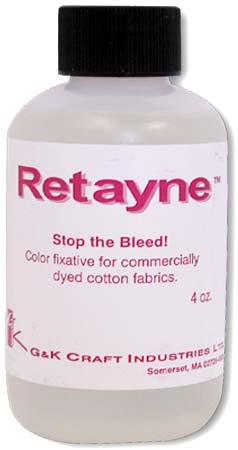
G&K Craft Retayne Color Fixative, 4-Ounce
Retayne is the most economical and effective
of the color fixative aftertreatments. It makes Rit dye stay bright much longer, instead of fading quickly in the wash.


Rit Dye Liquid Fabric Dye, 8-Ounce, Purple
Rit All Purpose Dye is a hot water dye, best applied in boiling water. It is not safe to use Rit Dye in cooking pots that will be reused for food preparation. Rit Dye fades quickly in the wash, compared to Procion dye, but a dye fixative such as Retayne can help it to last much longer.

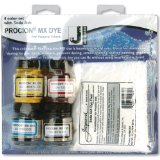
Jacquard Products Procion Four Color MX Dye Set with Soda Ash
Procion MX fiber reactive dyes can be used to mix any color you wish. Must be used with soda ash or washing soda as a fixative; machine dyeing also requires salt.

Country or region: USA
Message: I hope I'm not asking questions already asked-I did check the FAQ. I've read numerous articles on dyeing & now I'm totally confused; having problems from a head injury doesn't help. I have a dark brown, 100% cotton dress with some silk(?) ribbon bands sewn on around the hem line & several other places, as well as some crocheting at the top. I want to dye it dark purple. I have liquid Rit dye, Rit color remover, soda ash fixative & Retayne. Do I need to remove the brown prior to dying or can I dye right over the brown & achieve an eggplant type purple? I'm leaning toward a stove top method. How do I go about this? I've read all kinds of instructions from a multitude of sites (including Rit) & now I'm overwhelmed & just plain confused. Any help & direction you can give me would be so very appreciated. Thank you for your time & trouble.
(Please help support this web site. Thank you.)
Monday, July 08, 2013
Can you tell me if you have any outlets in the Philippines or UK?
—ADVERTISEMENTS—
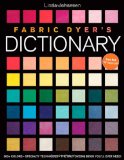
Linda Johansen's book
Fabric Dyer's Dictionary
shows how to mix a small number of Procion dyes to obtain a large number of different solid colors
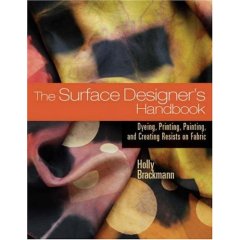
Holly Brackmann's book
The Surface Designer's Handbook
includes directions for dyeing with Procion MX dyes
Country or region: Philippines
Message: Can you tell me if you have any outlets in the Philippines or UK? Thank you.
(Please help support this web site. Thank you.)
Sunday, July 07, 2013
What fabric paint should I use to restore the color on a pet-stained wool rug?
—ADVERTISEMENTS—
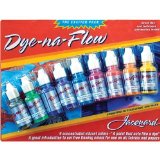
Jacquard Products
Dye-Na-Flow
Exciter Pack, 9-Color
Dye-na-flow is a thin, transparent fabric paint designed to flow like a dye.

Setacolor Transparent is a thin, transparent fabric paint which flows easily on dampened fabric.
Message: Hi, I have a very expensive custom made round wool area rug under my dining-room table. The center is a muddled light colbalt blue. My 12 year old little dog urinated on it and there is a urine stain which discolored the inner circle of the carpet. It turned a lighter blue and is very noticeable. The circumference of the circle where the stain appears is approximately 53in across. Is there any fabric paint you can suggest I use to see if I could paint that inner area of the carpet? That area does not get a lot of wear and tear. I am so hoping you might have a solution for me. The carpet new, cost me a few thousand dollars and I hate to get rid of it. Look forward to hearing back for you. Thanks, Steve
(Please help support this web site. Thank you.)
Saturday, July 06, 2013
Can you use soda ash after tie dyeing during the first wash? WIll it help if you didn't soak in soda ash pre-dyeing?
—ADVERTISEMENTS—
Country or region: US
Message: Can you use soda ash after tie dyeing during the first wash? WIll it help if you didn't soak in soda ash pre-dyeing?
(Please help support this web site. Thank you.)
Friday, July 05, 2013
Is it possible to dye a jacket which is 100% baumwoole? Name: Tracy
—ADVERTISEMENTS—
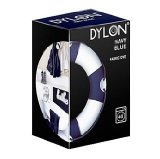
Dylon Machine Dye
Navy Blue
Dylon does not market their Dylon Machine Dye in North America, though it is widely available in Europe, but it is sometimes imported. It contains fiber reactive dye and is slightly easier to use than Procion MX dye, but less versatile in color, and more expensive.


Jacquard Products Procion Four Color MX Dye Set with Soda Ash
Procion MX fiber reactive dyes can be used to mix any color you wish. Must be used with soda ash or washing soda as a fixative; machine dyeing also requires salt.

Country or region: Kent, England
Baumwolle is simply the German word for cotton, so yes, IF it is washable, this jacket may be dyeable, regardless of how the fabric has been brushed. 100% cotton is a good fiber for dyeing.
Cotton does shrink, so a cotton jacket marked "dry clean only" (or the German equivalent) will probably not do well in dyeing. (See "Can I dye clothing that is labeled 'dry clean only'?".) Lined jackets, in particular, can be problematic, as the cotton will shrink more, when washed, than the usually synthetic lining material, ruining the shape of the garment. Dyeing always involves a lot of washing. If you have washed the jacket already, without a problem, then prospects are good.
If you don't happen to like any of the colors available in the Dylon Machine Dye line, then it is possible to obtain Procion MX fiber reactive dyes from several suppliers in the UK; see my page, "Sources for Dyeing Supplies Around the World", and look at my page, "How can I dye clothing or fabric in the washing machine?". The process is slightly more involved, since Procion MX dyes are sold without the dye activator (soda ash or washing soda) included in the Dylon Machine dye packet, and salt must be added, as well, but it is not difficult.
There is always a chance that dyeing will not go well even if you do everything right, so you should dye a garment only if you can accept a risk. Sometimes clothing that is not sold specifically for dyeing will do funny things when dyed. There may be a wrinkle-resistant finish that will reduce the overall color intensity, as it interferes somewhat with the dye's ability to access the fiber in the fabric. Never try to dye anything that has a stain-resistant finish, since dye is resisted the same way as stains. Sometimes one panel of the fabric, though matching perfectly in color before dyeing, will end up taking the dye much more intensely than another panel does, due to having been cut from a different bolt of fabric. If there is an invisible stain on the fabric, it might show up more obviously after dyeing. Usually, however, a machine-washable cotton garment will dye acceptably. Be sure to pre-wash the jacket thoroughly before dyeing, to reduce the risk of uneven dyeing.
Note also that color choice is important. If the jacket is white, you can dye it almost any color, though you should be aware that the stitching that holds commercial garments together is almost always polyester, which will not take any cotton dye and will remain the original color. It's important to keep in mind that, if the jacket has a color already, you can dye it only to a darker color. Because dye is transparent, the original color will always show through, combining with whatever color you add.
(Please help support this web site. Thank you.)
Thursday, July 04, 2013
I am trying to create a galaxy-like effect on black polyester non-roll elastic. What would I need to do it? Name: Fabulous
—ADVERTISEMENTS—
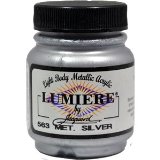
Jacquard Products Lumiere Fabric Paint: Metallic Silver

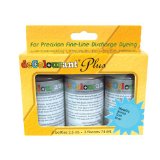
Metallic Decolourant Plus
Contains both a dye remover and a fabric paint, to remove the background and add metallic color at the same time!

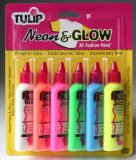
Tulip Paint Starter Kits-Neon/Glow
Glow-in-the-dark and blacklight-reactive fabric paints work best when painted over white spots in the fabric.

There are three different ways you could create white dots on a black background.
Probably the best method is to start with black material, and sprinkle on opaque, metallic, or pearlescent fabric paint, or carefully apply them with a fine-pointed brush. Metallic and pearlescent fabric paints would be particularly nice for a galaxy, I think. (Look at good color photos of space images to see the variety of colors in the different stars in a single galaxy!) Be careful to choose a brand of fabric paint which is recommended by the manufacturer for polyester, such as Jacquard Products Lumiere or Neopaque fabric paints. You could dip a toothbrush in the paint, and spatter it onto the fabric using a gloved hand; be careful to test your technique on some scrap material first! After allowing the fabric to dry, you will probably have to heat-set it with a hot iron; check the manufacturers' instructions. Later, when laundering the material, be careful to avoid abrasion in the washing machine; turn garments inside out, and place them inside a mesh lingerie-washing bag, before washing them, because fabric paint tends to wear badly in the washer or dryer.
It is possible to use a dye remover, instead of paint, to create white dots on a black background. Do not ever use chlorine bleach on polyester or other synthetic fabrics, because the bleach will yellow polyester, and will eat away at lycra and other stretch fabrics. You can safely use a sulfur-based dye color remover, such as deColourant spray or cream, or Jacquard Discharge Paste. It's a little more difficult than using fabric paint. A serious drawback with color remover techniques is that it is impossible to predict whether a given black dye will lose color at all; even if it works well one time, the next time you buy an apparently identical piece of elastic, it may have been dyed with a different black dye which does not work at all.
The third possibility is to apply a resist in the shape of the galaxy before using a black dye. For dyeing cotton, you might use spatters of wax, but this won't work for polyester, since all polyester dyes require high heat, which would melt the wax. However, you can apply black disperse dye by first painting it onto paper, then ironing it on to transfer the dye to polyester and other synthetic fibers; if you were to sprinkle little cut-outs of aluminum foil across the fabric before doing the heat transfer with the iron, they would prevent the dye from accessing the fiber, resulting in white spots in the shape of your aluminum foil cutouts. This is a wonderful method for smaller areas on smooth fabric, but is not suitable if you want all of your elastic material to be dyed evenly, since it is impossible to apply transfer dyes perfectly evenly to all of the material.
(Please help support this web site. Thank you.)
Wednesday, July 03, 2013
Name: Paul
—ADVERTISEMENTS—
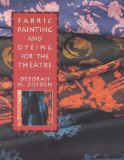
Fabric Painting and Dyeing for the Theatre
by Deborah Dryden
includes directions for dyeing with basic dyes
![]()
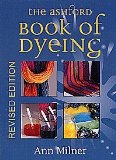
Ann Milner's book
The Ashford Book of Dyeing
includes directions for dyeing with basic dyes
![]()

Linda Knutson's book
Synthetic Dyes for Natural Fibers
discusses basic dyes but does not include directions for dyeing with them
Industrial Dyes: Chemistry, Properties, Applications
edited by Klaus Hunger
![]()
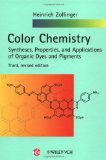
Color Chemistry, 3rd Edition
by Heinrich Zollinger
![]()
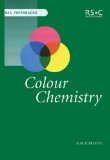
Colour Chemistry (RSC Paperbacks)
by R.M. Christie
Country or region: USA
Message: The nice people at Dharma suggested I post on your forum, but my question is so odd that I’m not sure where to place it.
I am trying to stain a granite rock dust to change it from dull grey to black. I was successful in doing this with Rit Black Azabache dye that I purchased at a local grocery store. Based on that success, I ordered Procion dyes from Dharma and am surprised to see that after an overnight soak in a water slurry bath, then drying in an oven, the dye completely separated from the stone and did not change the color at all. Dharma suggests maybe trying iDye since the chemistry is different, but I wanted to ask you first if you had any thoughts or recommendations?
Hi Paul,
What an interesting question!
First I had to wonder what Rit "Azabache" dye is, a more evocative and interesting color name than any Rit black dye name I have seen before. Turns out it's merely a matter of bilingual package labeling. "Azabache" is Spanish for "Jet", and just another way to say "black".
Next, there's no obvious reason to me to chose dye, rather than pigment. Procion MX dye is a dye that reacts with cellulose, other carbohydrates, and proteins; this makes it able to bond to wood, for example, but there's nothing about it that has any particular attraction toward granite. Rit dye is all-purpose dye, containing a mixture of detergent, salt, direct dyes for use on both protein and cellulose fibers, and acid dyes for use on protein fibers.
Dharma's suggestion to maybe try iDye would work if the direct dye is what's working in the Rit dye mixture, since iDye is a direct dye. However, it might be the acid dye in the mixture, rather than the direct dye, that worked in your Rit dye. It's also possible that the fact that Rit dye is primarily composed of detergent and salt, with only a little dye, helped the dye to adhere to the granite. A fourth possibility is that the black Rit dye mixture just happens to contain a dye with some tendency to stain stone, a property which you might not find in other colors of the same brand of dye, since different colors in the same line of dye contain different dye molecules.
Granite (as you must know better than I do) contains quartz, mica, and feldspar. All three of these minerals are based on silicates. I doubt that a dye optimized for attaching to cellulose or protein is going to have much affinity for granite. My experience with Procion and other fiber reactive dyes are that they don't much stain anything other than protein or cellulose.
The dyes in Rit dye and in Procion dye are soluble in water. This means that they would work, physically, to color anything that contains water, such as, say, agar gel. Since granite does not contain water, there is no advantage to water solubility in choosing a way to color it after it is dry. A black pigment, which by definition is not soluble in water, would make just as much sense to me as something to mix with granite dust to color it. Pigments are powdered substances which are used as colorants in paint, or mixed with liquid plastic before making solid things out of it; since they are not water-soluble, they are not likely to wash out in water, which could be important at some point. They are highly suitable for mixing with a liquid substance that will act as glue after it dries, causing it to stick to whatever they have been applied to. The choice of binder for a pigment depends on what properties it has to have in the long run, anything from soy milk to lacquer to polyurethane to acrylic paint binder. Water-soluble food dyes are transformed into aluminum-based insoluble "lakes" for use when pigments are needed, rather than dyes.
Granite dyes currently used on some commercially-available countertops appear to be solvent dyes. Solvent dyes are, as their name implies, soluble in oily substances, rather than in water, and are therefore resistant to washing with water. They are useful for coloring epoxy resin, so they are suitable for use on resin-coated granite or for cultured stone products that contain resin. The drawback of dyed granite countertops, as opposed to undyed ones, is that the dye is present only in a thin layer on the surface, so that it is subject, over time, to wearing off.
Is there any molecular charge to the components of granite? Both cellulose-fiber and protein-fiber textiles are negatively charged, and so are direct dyes, acid dyes, and reactive dyes. Another class of dye, basic dyes, is positively charged (they are also called 'cationic dyes'), so the dyes in that class are more inclined to cling to textile fibers by virtue of their molecular charge. Basic dyes are known for their tendency to stain just about everything else that they touch, too. Procion dyes do not stain plastic buckets or porcelain sinks, but basic dyes tend to stain just about everything the are spilled on. I wonder what they would do with granite. I would guess that there is no charge in granite to make them cling, but I don't know. It is possible that there is some basic dye in the Rit black dye that helped it to stain your granite, but we cannot tell because Rit's choice of dyes is a trade secret. There is no information anywhere, that I can find, on what actual dyes may be included in any Rit dye color.
I am not sure where to advise you to look for the types of dyes I have mentioned here. Solvent dyes and pigments are harder to come by, at least in the small quantities used by artists and home hobbiests, than direct dyes, acid dyes, and reactive dyes, since the dyes in the latter groups are useful in crafts projects. Companies such as Standard Dyes will sell quantities as small as one pound per color; they may be willing to send small quantities of each of several dyes for you to use in testing. They have several different lines of solvent dyes. PRO Chemical & Dye, which like Dharma Trading Company sells both small and large packages of dyes to individuals, sells a carbon black pigment among their PROfab Color Concentrates. Dharma's Pigment Dyes are already mixed with a binder, which may or may not be suitable for your purposes.
Paula,
Thank you so much for taking the time to write this informative email! Yes, I think you are correct that it makes sense to test cationic dyes since the granite has a negative surface charge. This may explain, in part, why the Procion didn't work. It also suggests that Rit would contain at least some cationic since it's all purpose dye. Can you tell please me which brand(s) are cationic? It doesn't seem like many websites offer this information, but I may be looking in the wrong place.
I'm glad to learn that granite has a negative surface charge, so basic dyes might meet your needs. I doubt that many of the Rit all-purpose dyes contain basic dyes, but some dyes used as acid dyes are actually basic dyes.
I know a few good places to buy basic dyes. The best one for small quantities is Aljo Mfg, in Manhatten. (Please tell them I sent you.) They sell them as "alcohol/water" dyes, because that is how these dyes are used for silk painting. They sell quantities as small as half an ounce per color. You will have to call them to order, because their website does not have online ordering. Ask whether they have one or several black basic dyes, since you will want to try all of them, if they have more than one.
Jacquard Products still sells basic dyes, in their online Bulk and Specialty Store, but their minimum order is one pound per color, which is a lot when you are just testing. Sometimes if you call and ask, a dye company will send a smaller sample.
Standard Dyes sells Permacryl Basic Dyes for Paper and Kayacryl Basic Dyes for Acrylic. It might be worth testing them, because at least some of them will be different dyes than from the other sources. Their minimum order size is one pound per dye color.
It's probable that all of the black basic dyes are actually mixtures of several colors. I don't have a single unmixed basic black dye in my chart of basic dyes. How satisfactory a given mixture will be depends on its use. You will need to do tests. If one mixture separates into navy blue, orange, and pink, try another to see if it does not separate out under your conditions.
For quite a lot more information on basic dyes, including safety cautions, please see my page, "About Basic Dyes". I would appreciate it if you will tell me how well the dyes you test work out for you.
(Please help support this web site. Thank you.)
Tuesday, July 02, 2013
Can I use watercolor paint for sun p[ainting fabric?
Name: Gail
—ADVERTISEMENT—
Sun Paint: Use Sunshine to Make Colorful Fabric Prints with Other and Paint Brush and PaintA Klutz book
by Barbara Kane

Pebeo Setacolor Transparent Fabric Paint

Setacolor Transparent is just one of many transparent fabric paints that can be used for sun printing.
Country or region: Colorado
Message: Re: Sun painting.... I do water color and was wondering if I use watercolor paint (student brands due to cost) if this would work for sun painting. I have considered the setacolors but they are so expensive and I would use then very little. Would mixing dye to a paste with the sodium agate (?) work just as well? I find I am a fabric dyer and not a fabric painter.
In sun painting, a thin transparent fabric paint is applied to fabric (usually damp fabric) that has been stretched on a frame or a piece of card or plastic; small objects are scattered on top of the painted fabric; finally, the whole is exposed to bright sunlight or a hot halogen lamp. As the paint dries in the sun-exposed areas, the pigment tends to migrate out of covered areas into the exposed areas, leaving lighter "shadows" of whatever objects were placed on the painted fabric.
Do not use watercolor paint on any fabric that you will ever want to wash. Watercolor paint will work for you only if you do not subject it to laundering. It would be disappointing to see your work gone after only a couple of trips through the washer. If you're not coloring wearables, most transparent watercolor paint will work for sun painting on thin fabric, assuming that your fabric will never be allowed to get wet again after you are done.
Sodium alginate is a thickener for dye or paints, but it does nothing to permanently attach a pigment to the fabric. For sun painting, you want your paint to be thin, not thickened at all, so you should never use sodium alginate in your paint when sun painting.
If you don't mind the harsh feel, then heavily diluted acrylic paint, such as Liquitex Soft Body Artist Acrylics, could be used for sun painting. If diluted with sufficient water and used on wet, tightly stretched fabric, acrylic paint will generally be able to perform in sunpainting. If you allow acrylic paint to dry on fabric for a long time, say for a month, and then press it with a hot iron, it will be reasonably resistant to being washed off in the laundry (always be sure to turn garments inside-out before washing, to reduce wear). There are two drawbacks to using artists' acrylics in place of fabric paint: one is that the paint feels much harsher to your skin than fabric paint, after it dries, and the other is that it can be more difficult to get it to adhere to the fabric.
The best way to use artists' acrylics as fabric paint is to buy some fabric medium, such as Golden GAC 900 Fabric Medium or Liquitex Fabric Medium, and mix it with the paint to make your own fabric paint. The fabric medium improves the feel of the paint after it dried, and helps it to soak into the fabric. You might be able to find fabric medium in your local art supply store; if not, you will have to mail-order it. I think that ordering fabric medium is as much trouble as just ordering fabric paint to begin with, but it will allow you to mix whatever quantity you need of any color you like. Be sure that you choose a product specifically labeled "fabric medium" or "textile medium"; there are many other types of acrylic media, but none of the others will work for turning acrylic paint into fabric paint.
Setacolor is not the only pre-mixed fabric paint that will work for sun painting. Any thin, transparent fabric paint should work. Setacolor is one option. Other well-tested options include Jacquard Dye-Na-Flow, PRO Chemical & Dye's PROfab textile paints, or really any thin fabric paint that is not opaque. Of course you will want to avoid metallic, pearlescent, slick, or puffy fabric paint. It's a good idea to do a small test with one color before investing in several colors of an unfamiliar brand of transparent fabric paint for a sun-printing project.
Also see my page, "How to Dye and Paint Fabric with Light", for more information about sun painting.
(Please help support this web site. Thank you.)
Monday, July 01, 2013
My greens are either coming out too dark or too bright. Can you help? Name: Gail
—ADVERTISEMENTS—

Linda Johansen's book
Fabric Dyer's Dictionary
shows how to mix a small number of Procion dyes to obtain a large number of different solid colors

Holly Brackmann's book
The Surface Designer's Handbook
includes directions for dyeing with Procion MX dyes
Country or region: Colorado
To make a green lighter in value, use less dye for a given weight of fiber (fabric, yarn, roving, or whatever). For a pale pastel, try as little as one-tenth as much dye per ounce of fiber, as compared to the amount you use for an intense green! Weigh your fiber while it is still dry, before dyeing, so that you will be able to make your calculations. See my page "How much Procion MX dye should I use?" , and scroll down to find Table II, showing guidelines as to how much dye powder you might want to use for a given weight of fiber.
To make a green less bright in color, add either a tiny bit of the opposite color on a color wheel, which is red, or add a neutral toning color, such as gray. This will result in a duller green. If you want to buy a pre-mixed neutral toning color, be sure to buy a gray dye, not black, because black dyes, when diluted, usually turn out to not be neutral, but instead have a tendency toward some color such as blue or purple.
Another way to get a green that is less bright is to start with duller mixing primaries. (See "Which Procion MX colors are pure, and which mixtures?" for a good list of Procion MX dye primaries to use.) You can substitute a navy blue, such as Procion blue MX-2G, mostly sold under the name "cobalt", for the usual bright turquoise primary, and you can substitute a golden yellow for the usual brilliant yellow, Procion yellow MX-8G. The golden yellow will make a more olive sort of green than the pure yellow MX-8G will.
Have you tried the Procion color mixing charts on my website? Maybe one of those recipes will work better for you if you just use less dye powder, per pound of fiber. The Jacquard Products Procion Mixing chart has recipes for pea green, seafoam, new aqua, blue spruce, teal, jade, yellow green, chartreuse, vermillion green, lime green, shamrock, fern green, sage, fatigue green, avocado, artichoke, desert green and olive. See my page, "How can I mix Procion MX dyes to get specific colors?".
I strongly advise every dyer to play at least a little bit with Olli Niemitalo's Dye Mixer Applet; there is a link to it on my color mixing page that I just linked to. It's a wonderful tool for visualizing what colors you want to mix in order to get a certain result.
(Please help support this web site. Thank you.)


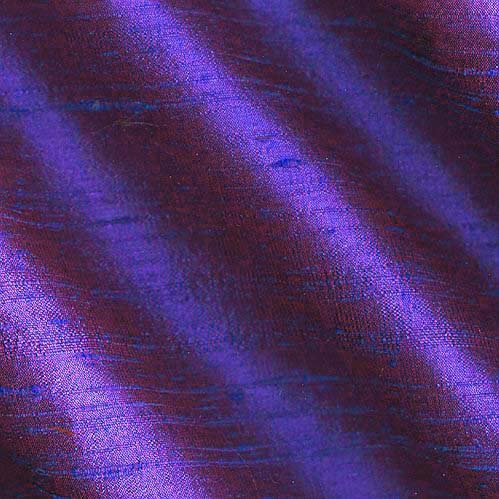 iridescent
iridescent
